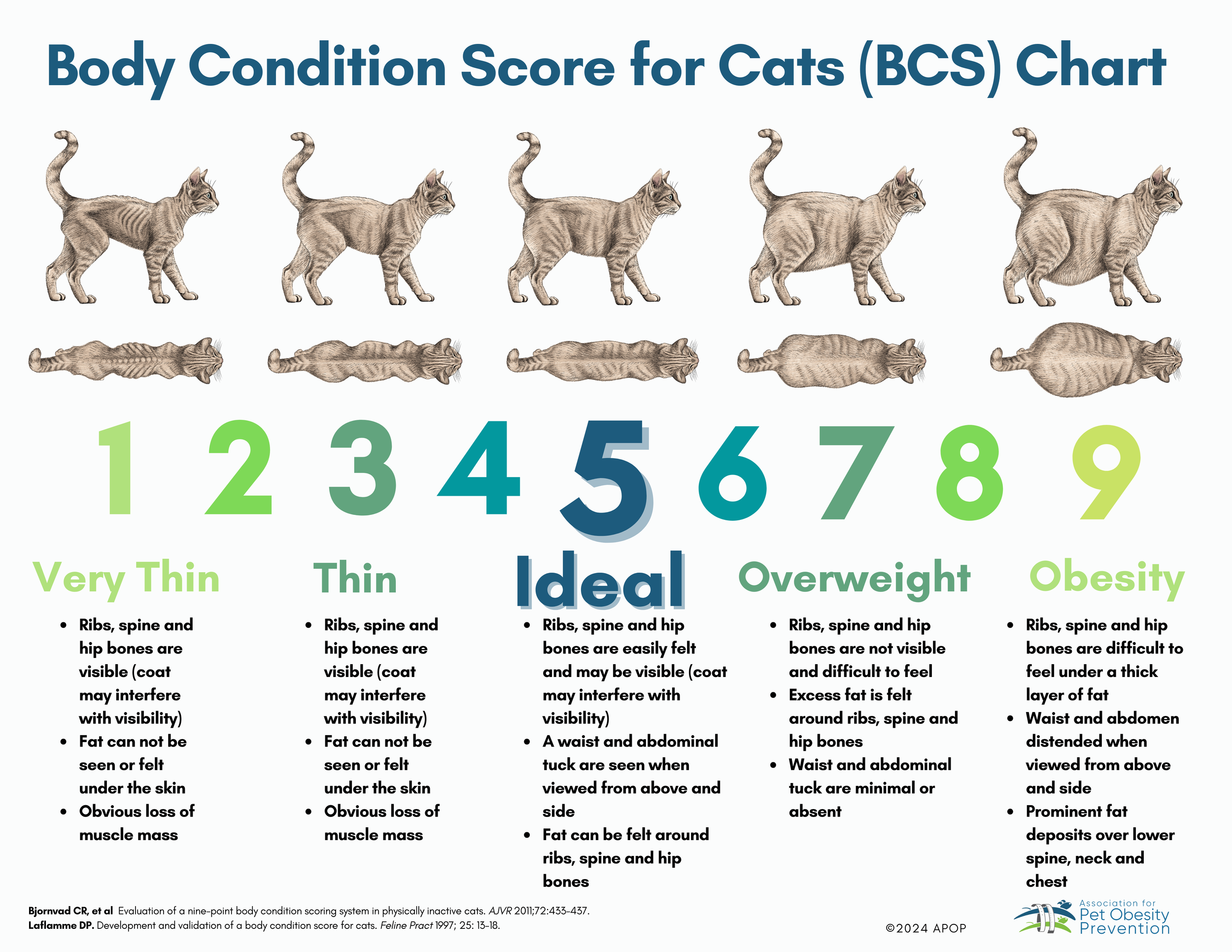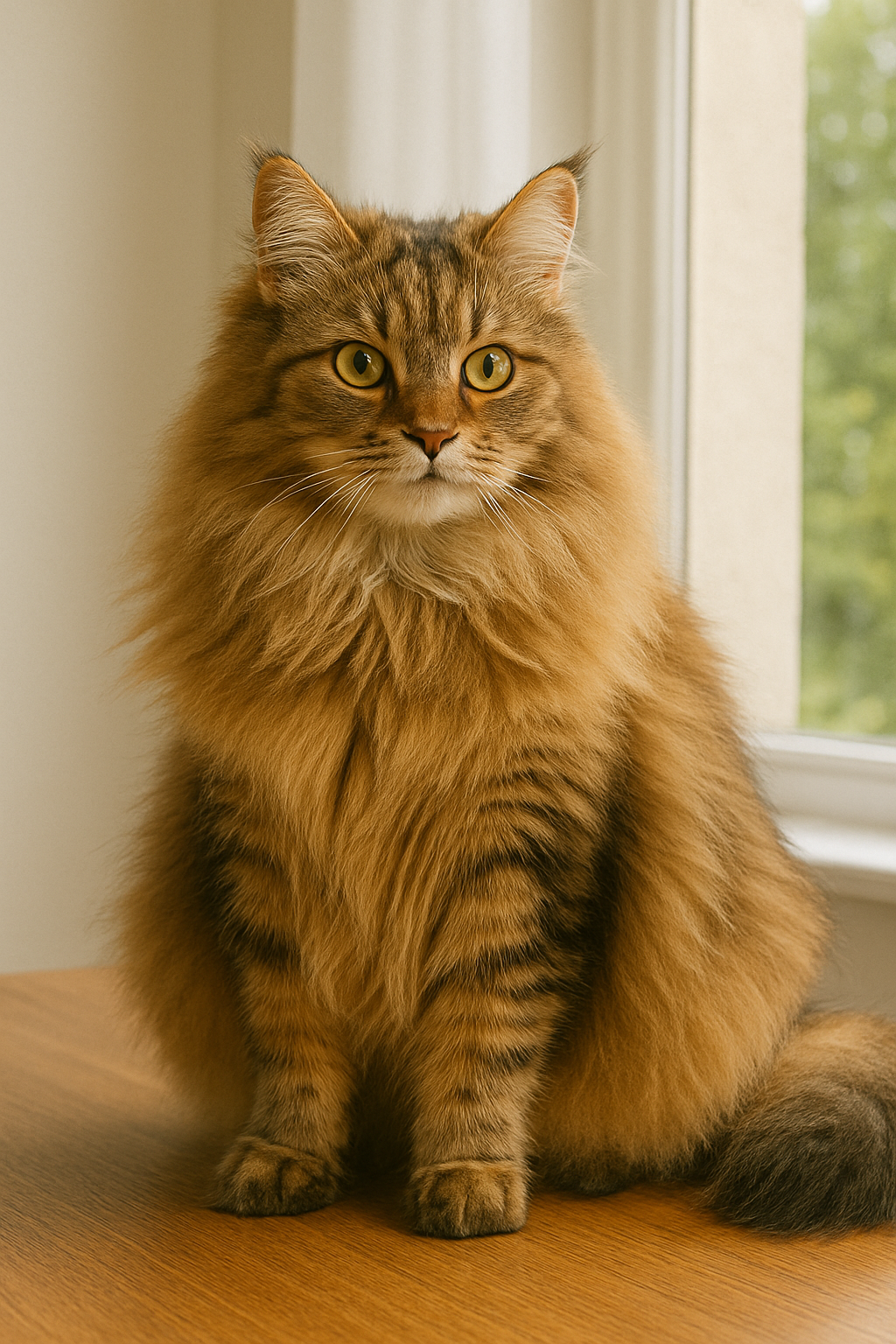Cat Body Condition Score Chart(BCS)
A cat body condition score is a visual and hands-on way to assess fat and muscle coverage, helping determine whether a cat is underweight, overweight, or at an ideal body condition.
Stand above your cat and look for a visible waist just behind the ribs. From the side, check for a slight abdominal tuck. With gentle pressure, you should be able to feel the ribs without digging. Palpate the ribs, waist, abdomen, spine, and hips and compare what you feel to a standard BCS chart.
What an Ideal Body Condition Looks Like: A cat with a healthy body condition has a visible waist when viewed from above and a slight abdominal tuck when seen from the side. The ribs are easy to feel with a light touch but not visible. The spine and hip bones can be felt but are covered with a smooth, moderate layer of fat.
- Too thin: ribs, spine, and pelvis easily visible or felt with little fat cover
- Ideal: ribs easy to feel, visible waist, slight abdominal tuck
- Overweight/Obesity: ribs difficult to feel, no waist, rounded or sagging abdomen
- Ribs
- Waist (viewed from above)
- Abdominal tuck (viewed from side)
- Spine & hips
Record your cat’s score regularly to track changes over time and discuss results with your veterinary team.
How to Check Your Cat’s Body Condition
At-Home Pet Body Condition Score (BCS) Assessment: Check if Your Cat Has a Healthy Body Condition
Routine body condition assessments are essential for monitoring your cat’s health and managing weight-related issues. A hands-on evaluation can help determine where your cat falls on the 1–9 Body Condition Score (BCS) scale and guide appropriate care.
1. Ensure the Cat is Comfortable and Calm
Begin by placing your cat in a quiet, familiar environment. The cat may be standing, sitting, or lying down naturally—the assessment can be adapted based on your cat’s preferred position.
Use gentle, soothing touches while palpating key areas, and provide plenty of reassurance throughout the process to keep the cat relaxed and comfortable.
2. Assess the Ribs
Gently run your fingers along the ribcage, starting just behind the front legs.
In a cat with an ideal body condition, the ribs should be easily felt but not visible, with a thin layer of fat covering them.
If ribs feel sharp or very prominent → your cat may be underweight.
If the ribs are difficult to feel or buried under fat → your cat may be overweight or have obesity.
Tip: Palpation is more reliable than visual assessment—especially in long-haired cats.
3. Check for Fat Deposits
While examining the ribs, note any excess fat accumulation in common areas such as the chest, abdomen, and base of the tail. Localized fat pads can be an early indicator of unhealthy weight gain.
4. Examine the Spine and back
Gently run your hands along the spine from the shoulders to the hips.
You should feel defined vertebrae, but they should not feel overly sharp.
A prominent spine suggests underweight; a spine padded with fat may indicate overweight or obesity. In underweight cats the spine will feel prominent and sharp, while in overweight cats it will be padded or hard to feel.
5. Feel the Hips
Palpate the hips and surrounding muscle.
In a cat with healthy body condition, the hip bones are detectable but not protruding. In an underweight cat, the hips will feel bony and lack softness. In an overweight cat, the hips will be padded or difficult to feel due to fat deposits.
Bony, sharp hips = underweight.
Rounded, hard-to-feel hips = overweight or obese.
6. Evaluate the Abdomen and Primordial Pouch (Side View)
Gently feel the abdomen and observe the side profile.
An ideal body condition will show a gradual upward slope from the ribcage to the hind legs (abdominal tuck).
The primordial pouch—a loose, swinging flap along the abdomen—is normal and not necessarily a sign of excess fat.
Severe tuck = underweight
No tuck, sagging or bulging belly = overweight or obesity
7. Look for a Waist (Top View)
View the cat from above and check for a waistline behind the ribs.
An ideal body condition has a slight taper toward the hips.
A very narrow waist may suggest underweight.
A broad, rounded body shape with no visible waist indicates overweight or obesity.
Make Assessment Routine
Feeling and observing key areas of your cat’s body can help determine their body condition. Regular assessments are essential for monitoring overall health and managing weight safely and effectively. Monthly Body Condition Score (BCS) evaluations help track changes over time and allow for early intervention when needed.
Before beginning any weight loss plan, consult your veterinarian to rule out underlying medical conditions and reduce the risk of complications such as hepatic lipidosis (fatty liver disease). Hepatic lipidosis is a life-threatening condition that can occur if a cat loses weight too quickly due to inadequate calorie intake or nutritional imbalance. Professional guidance ensures that weight management is safe, gradual, and effective.
Pet Owners often misjudge body condition — even with a BCS chart.
Many pet owners see “normal” when a pet is actually overweight, and may overestimate thin pets. These misperceptions occur across species, even when using a Body Condition Score (BCS) chart. A quick BCS check is helpful, but regular veterinary evaluations remain the most reliable way to understand a pet’s condition and overall health.
-
The primordial pouch is a normal anatomical feature that serves to allow for expansion of the abdomen, especially useful for movement and stretching in cats.
-
The primordial pouch is a normal anatomical feature that serves to allow for expansion of the abdomen, especially useful for movement and stretching in cats.
Telling the difference between the primordial pouch and abdominal fat in cats can sometimes be confusing, but they have distinct characteristics.
Here’s how you can tell the difference:
Location
The primordial pouch is located along the midline of the abdomen, generally behind the ribcage and extending towards the hind legs.
Abdominal fat may be more pronounced over the entire belly, rather than being confined to a specific area.
How it Feels
The Primordial Pouch feels like a soft, loose flap of skin rather than a solid mass.
Abdominal fat feels thicker and more solid.
How it Moves
The Primordial Pouch is flexible and typically moves easily when touched or when the cat moves.
Abdominal fat feels firmer to the touch and is less mobile.
How it Looks
The Primordial Pouch has a loose, sagging appearance and is often more noticable when the cat is stretching or sitting.
Abdominal fat can cause the abdomen to look more rounded or distended.
-
Longer fur can obscure the body’s underlying structures, making it more challenging to visually assess fat distribution and the pet's overall condition.
Cats like Maine Coons and Persians have dense, fluffy coats that can obscure their body’s structure, making it harder to visually assess fat distribution. Careful palpation of the ribs, spine, and waist area is needed to get an accurate assessment.
Part the Fur: Gently part the fur to access and palpate the key areas. This can help in feeling the body structure more accurately.
Regular Grooming: Regular grooming of long-haired pets can help make the body condition assessment easier by reducing fur thickness and mats.
Focus on Feel: Regardless of the coat length, focus on feeling the ribs, spine, hips, and abdomen rather than relying solely on visual assessment.
By adjusting your approach based on the cat's coat length, you can more accurately assess body condition and ensure a proper evaluation for both short-haired and long-haired cats.
-
Pets with significant muscle loss may appear thinner, even if they have an average amount of fat.
The term "skinny fat" refers to a condition where a pet appears to be thin or at a healthy weight but has a higher body fat percentage and lower muscle mass. This condition can be misleading because the pet may not have visible fat deposits but still lacks muscle tone.
Causes of Muscle Loss
Health conditions such as chronic illness, cancer, kidney disease, or hormonal imbalances (e.g., hypothyroidism) can lead to muscle wasting.
Age - Older pets often experience muscle loss due to natural aging and decreased activity levels
Inactivity: Prolonged periods of inactivity or immobility, such as during recovery from surgery or injury, can contribute to muscle loss.
Nutritional Deficiencies: Inadequate protein intake or poor-quality diet can result in insufficient muscle maintenance and growth.
-
Stockier Breeds: Breeds like British Shorthairs tend to have more muscular, compact builds, which can make them appear heavier than they are. This can lead to overestimating their body condition if you're only relying on looks.
Slender Breeds: Breeds like Siamese and Orientals naturally have leaner, more angular physiques, and their ribs may be more prominent even when they are at a healthy weight. It's important not to assume they're underweight based on appearance alone.
Size vs. Fat: Maine Coons are naturally large and muscular. It's important not to confuse their size with being overweight. Look for fat deposits in key areas like the ribs and abdomen rather than focusing on their overall size or weight.
Feline Body Condition Score 1-9 with Descriptions
1 Emaciated
Extremely emaciated with very poor body condition.
Ribs: Projects prominently, with sharp bony edges; no layer of fat; easily visible on short-haired cats
Back/Spine: Project prominently
Hips: Clearly visible, sharp and protruding
Abdomen: Severe abdominal tuck with a concave appearance
Waist (from above): Extremely narrow with an hourglass shape
2 Very Thin
Ribs: Easily felt with a very minimal layer of fat; visible on short-haired cats
Back/Spine: Project prominently, with sharp bony edges
Hips: Visible and prominent with bony edges
Abdomen: Very pronounced abdominal tuck with a concave appearance
Waist (from above): Very narrow with an extreme hourglass shape
3 Thin
Ribs: Easily felt with a slight covering of fat; visible on short-haired cats
Back/Spine: Project prominently with sharp bony edges
Hips: Visible
Abdomen: Has a pronounced abdominal tuck and a small amount of abdominal fat
Waist (from above): Visible waistline
4 Moderately Thin
Ribs: Easily felt with a light covering of fat; not visible
Back/Spine: Spine can be felt
Hips: Less bony with a layer of fat coverage; still visible in short-haired cats
Abdomen: Slight abdominal tuck with a small fat pad
Waist (from above): Noticeable waistline, but not overly narrow
5 Ideal
Ribs: Can be felt and has a slight fat covering
Back/Spine: Smooth and easily felt but not sharp or bony
Hips: Rounded with a layer of fat
Abdomen: Slight abdominal tuck with a small fat pad
Waist (from above): Noticeable waistline behind the ribs with a gently curved hourglass shape
6 Moderately Above Ideal
Ribs: Can still be felt but with more difficulty; not visible
Back/Spine: Can still be felt
Hips: Able to feel; no longer visible; some fat deposits present
Abdomen: Minimal abdominal tuck with a slight rounding of the abdomen
Waist (from above): Not defined
7 Overweight
Ribs: Difficult to feel under fat accumulation
Back/Spine: Becoming difficult to feel
Hips: Able to feel with some pressure; not visible; fat deposits present
Abdomen: No abdominal tuck with a rounded appearance
Waist (from above): Barely visible or absent; body appears more rounded from above
8 Obesity
Ribs: Very difficult to feel under layer of fat
Back/Spine: Very difficult to feel
Hips: Difficult to feel under a layer of fat, little definition; not visible
Abdomen: Pronounced rounding of the abdomen and distension
Waist (from above): Not visible, broad and rounded from above
Notable fat deposits on the body
9 Severe Obesity
Ribs: Unable to feel
Back/Spine: Difficult to feel
Hips: Heavily padded with significant fat deposits; no definition
Abdomen: Large hanging fat pad
Waist (from above): No waist, broad and rounded from above
Significant fat deposits are noted over the lower spine, neck and chest







